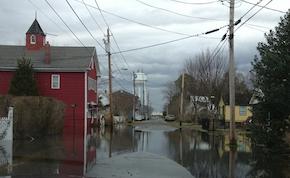Regular flooding of public and private property is simply a fact of life that burdens people living in the Town of Oxford on Maryland’s Eastern Shore. However, the University of Maryland’s Environmental Finance Center recently released a study that takes a close look at stormwater and flood management issues in Oxford and offers research-based recommendations for improving conditions in the town.
 “We heard from multiple residents and business owners who told us the risk of flooding is part of the bargain that comes with living in a beautiful coastal town like Oxford,” said Sean Williamson, program manager at the Environmental Finance Center. “Yet there is an overwhelming sense that something more can and should be done to reduce that risk.”
“We heard from multiple residents and business owners who told us the risk of flooding is part of the bargain that comes with living in a beautiful coastal town like Oxford,” said Sean Williamson, program manager at the Environmental Finance Center. “Yet there is an overwhelming sense that something more can and should be done to reduce that risk.”
The year-long study, supported by the National Fish and Wildlife Foundation, finds that stormwater infrastructure, which stores and conveys rainfall or tidewaters, and shoreline management capable of addressing the reality of sea level rise, are closely related-issues key to solving Oxford’s water woes. The chief recommendation from the study is for Oxford to adopt a local stormwater and shoreline protection fee that will raise the revenue necessary to invest in infrastructure such as constructed wetlands or stormwater pumps. Chesapeake Bay water quality and flood-related pollution runoff are also addressed in the study.
The Environmental Finance Center presented findings and recommendations to the Oxford community, including town commissioners, in September 2013 and the full report was released in December 2013.
 Working in parallel to the Environmental Finance Center, students in a graduate landscape architecture course at the University of Maryland adopted Oxford as their Fall 2013 case study. The students looked at the combined effects of sea level rise, storm surge, and stormwater in their landscape design proposals for Oxford.
Working in parallel to the Environmental Finance Center, students in a graduate landscape architecture course at the University of Maryland adopted Oxford as their Fall 2013 case study. The students looked at the combined effects of sea level rise, storm surge, and stormwater in their landscape design proposals for Oxford.
“A lot of climate change modeling information is examined at such a large scale that anticipating the local impacts is difficult,” observed Dr. Victoria Chanse, Assistant Professor at the university’s Department of Plant Science and Landscape Architecture and the course instructor. “At the local level, developing appropriate design and planning responses requires matching compatible options rather than finding a single solution.”
The students were challenged to provide a package of design and planning options that would address sea level rise impacts holistically in Oxford. The array of proposed solutions was supported by visual representations such as maps and schematics and varied in timeframe, scale and vision.
Dr. Chanse presented students’ real-world designs at an Oxford Interim Park Committee meeting. Additionally, several of the student proposals were submitted to the Maryland Sustainable Growth Challenge and were awarded first place in the competition held this January.
“I’ve attended the meetings held in the community, read the EFC report, and spoken with fellow Oxford residents about the recommendations,” says Jock Beebe, an Oxford resident. “The report lays out the flooding problems here and offers a practical plan for addressing the situation. It’s obviously the right thing to do for the Town of Oxford, surrounded as it is by Chesapeake waters.”
The full Environmental Finance Center report and select projects from the Advanced Topics Studio can be found online at: https://efc.umd.edu/oxford.
A number of partners were integral to completing the Oxford study and facilitating the student projects, including: Oxford town officials; GMB, LLC, an engineering firm; Preservation Green, a landscape architecture firm; and non-profit organizations including the Eastern Shore Land Conservancy and the Chesapeake Bay Foundation.
..



Write a Letter to the Editor on this Article
We encourage readers to offer their point of view on this article by submitting the following form. Editing is sometimes necessary and is done at the discretion of the editorial staff.